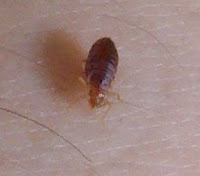I've had numerous people in the past month calling with "bed bug" problems. After encouraging samples to be submitted for identification, I discovered that while some people had problems with bed bugs, others had carpet beetles. I want to point out that just because a "bug" is found on a bed does not necessarily mean that it is a bed bug.
Carpet beetles and bed bugs are quite different. First of all, they are in different orders. Carpet beetles are in Coleoptera while bed bugs are in the order Heteroptera. Carpet beetles have chewing mouthparts while bed bugs have piercing-sucking mouthparts. Carpet beetles have complete metamorphosis- egg, larva, pupa, adult. Bed bugs have incomplete metamorphosis- egg, several nymphal stages, adult.
| Carpet beetle adult. |
 |
| Bed bug. Photo by Alan Brown. |
Bed bugs are brown to reddish-brown, small insects without wings. The body is oval and color varies depending upon whether the insect is engorged with blood. The nymphs look very similar to the adults, but are smaller in size and lighter in color. Both nymphs and adults feed on blood and can be found around sleeping areas of their host.
Here comes the tricky part- both carpet beetles and bed bugs can be found on a bed. If you know their biology (see above) then it makes sense. Bed bugs can be on the bed to be near their host that provides a blood meal. Carpet beetles can be found on a bed because of food, but they are not feeding on blood. Food for carpet beetles on a bed can range from feathers inside blankets and pillows to pet hair (if you're like me and you have a menagerie sleeping with you).





